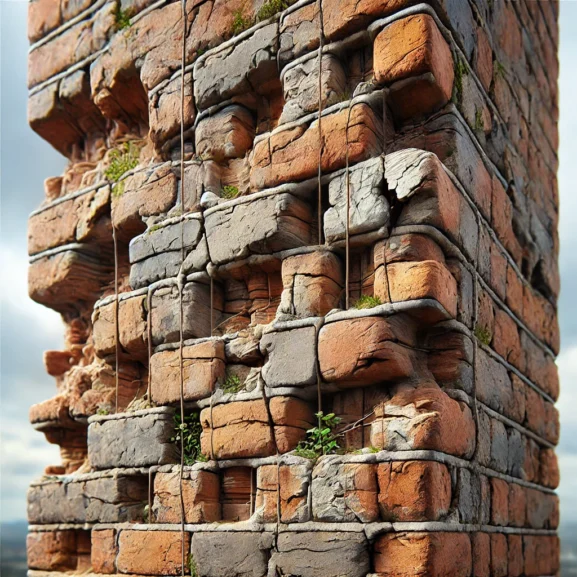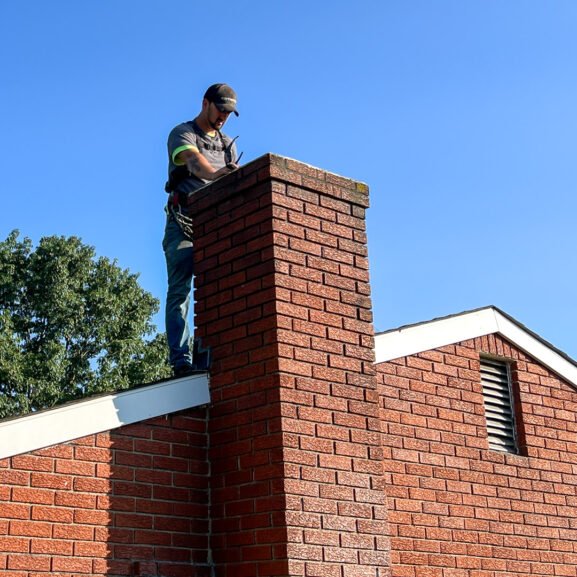Preventing Loose Chimney Bricks Caused by Mortar Degradation: Essential Maintenance Tips
Every time we light a cozy fire, we rarely consider the unseen dangers lurking above. Loose chimney bricks might seem trivial, but they’re often a red flag for a more insidious issue: mortar degradation. As the mortar crumbles, it weakens the structural integrity of the chimney, posing potential risks to our homes and safety.
Understanding why mortar breaks down is crucial. Factors like weather exposure, age, and poor maintenance can accelerate the process, leaving our chimneys vulnerable. In this text, we’ll explore the causes of mortar degradation and how it leads to loose chimney bricks. We’ll also discuss preventative measures and repairs to ensure our homes remain safe and sound. Let’s jump into the world of chimneys and safeguard our hearths.
Ultimate Guide to Mortar Degradation: Causes, Effects, and Remedies
Understanding mortar degradation keeps chimneys safe and stable. Let’s explore what it means and how it affects chimney bricks.
What Is Mortar Degradation?
Mortar degradation refers to the process where the binding material in masonry weakens over time. This degradation can lead to loose chimney bricks and cracked chimney mortar. It’s an invisible enemy—like that sock-eating monster in your dryer.
Mortar acts as the glue for brick-and-mortar structures. When this “glue” erodes, it causes mortar joint erosion and affects the entire chimney structure. The weakened mortar can’t hold bricks firmly, escalating into spalling bricks and other structural issues.
For professional chimney maintenance and to avoid these loose brick hazards, reach out to professionals for consultation.
Common Causes of Mortar Degradation
Several factors contribute to the deterioration of chimney mortar. The prime suspect? Weather exposure. Freeze-thaw cycles are especially hard on chimneys, leading to cracks and chimney mortar erosion.
Age and maintenance play roles too. Over time, mortar naturally degrades. Without regular inspections, this process accelerates. Poor initial workmanship can cause premature degradation, leaving your chimney more vulnerable.
- Weather: Rain, snow, and sun all take their toll.
- Age: As chimneys get older, materials weaken.
- Poor Maintenance: Regular check-ups are essential.
- Initial Workmanship: Good work lasts longer.
To stay informed about fire safety and prevent mishaps, check NFPA and CSIA for guidance. Call us for expert help and let’s tackle that pesky mortar.
Signs of Loose Chimney Bricks
Loose chimney bricks are more than just an eyesore. They compromise safety and signal mortar breakdown. Knowing what to look for can prevent accidents.
Visual Indicators
Spotting loose chimney bricks doesn’t require a detective. Keep an eye out for these signs:
- Cracks in Mortar: Gaps where mortar should tightly bind bricks suggest mortar joint erosion.
- Spalling Bricks: If surfaces flake or crumble away, bricks are experiencing spalling due to weather.
- Dislodged Bricks: Bricks that appear uneven or missing need urgent attention.
Think of these as your chimney’s way of raising a red flag. For further insights, the Chimney Safety Institute of America offers extensive information on this topic.
Structural Warning Signs
Chimney instability often involves more subtle clues:
- Leaning Chimney: If your chimney seems to host a lean reminiscent of the Leaning Tower of Pisa, it’s not an architectural choice. It’s a call for masonry repair.
- Interior Wall Cracks: Cracks appearing on walls near the fireplace indicate stress on your chimney structure.
- Fireplace Rust: Rusted damper or firebox hints at moisture issues tied to cracked chimney mortar.
Climate with its freeze-thaw cycles, further complicates matters. When these signs appear, it’s best to consult professionals. Don’t delay; reach out to professionals for consultation and check NFPA’s resource for more on chimney safety.
Ready for chimney peace of mind? Avoid becoming a victim of loose brick hazards. We handle everything—except DIYs.
Risks Associated with Loose Chimney Bricks
Loose chimney bricks, a result of chimney mortar deterioration, pose real dangers that shouldn’t be ignored. Their potential threats span from safety risks to property devaluation. Let’s look at these in more detail.
Safety Concerns
Loose bricks are more than just a headache—they’re a hazard. When mortar joint erosion occurs, it compromises the stability of a chimney. Falling bricks could injure anyone passing by or damage property below. Worse still, cracked chimney mortar can lead to structural instability, creating a pathway for dangerous gases to enter the home. So, keep your family safe and your chimney solid. Don’t try DIY fixes for these issues. reach out to professionals for consultation.
For more information about chimney safety, visit the Chimney Safety Institute of America or the National Fire Protection Association.
Impact on Property Value
Not fixing loose chimney bricks impacts home value. Potential buyers spot signs of masonry repair needs, like spalling bricks and brick-and-mortar degradation. A leaning chimney or visible disrepair can cause buyers to second-guess, potentially lowering your home’s market appeal. In areas, where weather wreaks havoc on homes, regular chimney maintenance becomes vital. Our experts can help maintain your property’s curb appeal and protect its value. Our consultation ensures you don’t get stuck with unwanted surprises when selling your home.
Repairing Loose Chimney Bricks
Addressing loose chimney bricks and mortar joint erosion is crucial for maintaining chimney safety. Chimneys face unique challenges due to harsh weather, which can accelerate brick-and-mortar degradation.
- Inspect the Area: Check for cracked chimney mortar and spalling bricks. Identifying problem areas helps us understand the extent of masonry repair needed.
- Clear Loose Debris: Remove loose bricks and old mortar. This ensures new mortar adheres properly and extends chimney structure stability.
- Mix New Mortar: Use the correct ratio for a durable mixture. Accidents happen, but we want the mortar sticking together—not to our shoes!
- Reapply Mortar: Fill gaps where mortar joint erosion occurred. Press it firmly to secure loose chimney bricks.
- Replace Bricks: Set each brick back in place. Tap gently to ensure a snug fit.
- Dry and Cure: Allow mortar to set. Cue the tea—this part takes a bit.
Always consult professionals for these tasks. reach out to professionals for consultation. For more tips on chimney safety, visit the Chimney Safety Institute of America or National Fire Protection Association.
Preventing Future Mortar Degradation
Stopping chimney mortar from crumbling is key to keeping loose bricks in check. Regular maintenance and using the right materials are crucial for chimney safety.
Regular Maintenance Tips
Regular checks ensure your chimney stays strong. When it comes to battling brick-and-mortar degradation, action beats reaction! Here are some simple tips:
- Annual Inspections: Have a pro inspect your chimney once a year. This helps catch mortar joint erosion early. Sudden changes aren’t fun unless they’re in your milkshake order.
- Weather Shielding: Waterproof your chimney to ward off wild weather swings. This keeps cracked chimney mortar from becoming a “brickfall” waiting to happen.
- Clean Sweep: Clean chimneys mean healthy chimneys. Clear away soot to avoid loose chimney bricks. reach out to professionals for consultation or learn more from the Chimney Safety Institute of America.
Suitable Materials for Longevity
Choosing the right materials means longevity. Not all mortar is the same, and using durable materials prevents future headaches.
- Quality Mortar: Use high-quality, weather-resistant mortar to keep the structure stable. It’s our secret weapon against the freeze-thaw cycles.
- Brick Choices: Opt for bricks that resist spalling. This little tweak goes a long way in preventing nasty repairs.
- Sealants: Apply good sealants to withstand moisture. It’s like a raincoat for your chimney. Consult masonry repair experts to ensure the right application.
For further advice and support, contact us to make your chimney last. Plus, consult recognized guides like those from National Fire Protection Association.
Conclusion
Addressing loose chimney bricks caused by mortar degradation is crucial for maintaining both safety and property value. Regular inspections and professional maintenance are essential steps in preventing further deterioration. By understanding the signs of mortar breakdown and taking proactive measures, we can safeguard our homes from potential hazards. Investing in quality materials and professional expertise ensures the longevity and integrity of our chimneys. Let’s prioritize these actions to protect our families and homes from the risks associated with neglected chimney maintenance.
Frequently Asked Questions
What causes mortar degradation in chimneys?
Mortar degradation in chimneys is primarily caused by weather exposure, age, and inadequate maintenance. Harsh weather, especially freeze-thaw cycles, can erode the mortar over time, weakening its binding strength and compromising structural integrity. Regular inspections and timely maintenance are crucial to prevent such deterioration.
What are the signs of loose chimney bricks?
Signs of loose chimney bricks include cracks in mortar, spalling bricks, and dislodged bricks. Structural indicators might include a leaning chimney, cracks on interior walls near the fireplace, and rust in the fireplace, indicating serious stress on the chimney structure.
Why are loose chimney bricks dangerous?
Loose chimney bricks pose safety risks as they can fall and injure individuals or damage property. They also allow dangerous gases like carbon monoxide to enter the home, and visible masonry issues can reduce property value, especially in challenging weather conditions.
Can I repair loose chimney bricks by myself?
While minor repairs might seem manageable, DIY fixes for loose chimney bricks are discouraged due to safety risks and the potential for improper repairs. It’s best to consult professionals who have the expertise to ensure safe and effective corrections.
How can I prevent future mortar degradation in my chimney?
Prevent future mortar degradation by scheduling annual chimney inspections with professionals, waterproofing the structure, and keeping it clean. Use high-quality, weather-resistant materials such as mortar and bricks that resist spalling, and apply appropriate sealants to extend the chimney’s lifespan.
Why is regular chimney maintenance important?
Regular chimney maintenance is vital to catch potential issues early, preventing hazardous situations and preserving property value. Proper maintenance also ensures the chimney remains structurally sound, avoiding costly repairs by addressing problems promptly with professional assistance.

